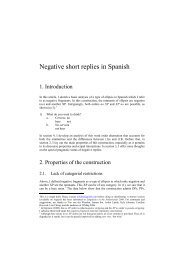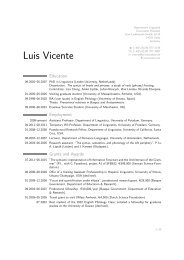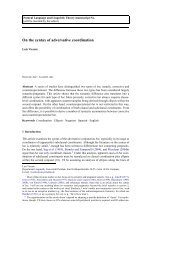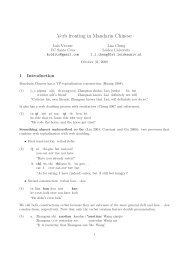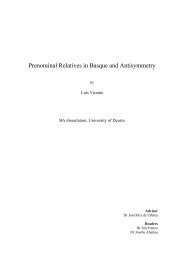November 27 - Luis Vicente
November 27 - Luis Vicente
November 27 - Luis Vicente
You also want an ePaper? Increase the reach of your titles
YUMPU automatically turns print PDFs into web optimized ePapers that Google loves.
AM2 — Syntax: theories and modelsWeek 7: Movement and phases1 PhasesA phase is what, in earlier versions of transformational grammar, used to be called a boundingdomain or a cycle. Properly, it is simply the bit of syntactic structure comprised between twophase heads. Its significance comes from the fact that certain syntactic operations (includingmovement) can apply within phases, but not across them.Formally, a phase is defined as follows: we have a phase head, and its complement is thephase domain. The phase head itself plus its specifiers and adjuncts are the phase edge. Phaseedges are special in that they are also part of the domain of the next higher phase.(1) XPphase edge(also domain of next phase)X’phase head(also phase edge)(also domain of next phase)phase domainIn this course, we will follow the mainstream hypothesis that v and C are phase heads, andthe rest of heads (V, T, etc) are not. Inside DPs, it is also usually assumed that D is a phasehead, but we don’t have to worry about that because we will not be saying a lot about theinternal structure of DPs. If we factor these categories into our template for phases, we getthe following structure.(2) CPedge CP C’C TPedge/head CPdomain CP T’T vPdomain CPedge vP v’domain CPvedge/head vPdomain CP Vdomain vPVPdomain vP1
Week 7 2 of 5Now we can define the following condition:(3) Phase Impenetrability Condition (PIC)Merger of a phase head causes the constituents in its domain to be spelled out (i.e.,transferred to the LF and PF interfaces). Spelled out constituents are inaccessible forfurther syntactic operations.(4) Cyclicity (corollary of PIC)Movement can only happen inside a phase domain. In order to move from one phasedomain to the next one, movement has to stop first at the relevant phase edge.In other words () is a licit instance of movement, but () is not. Movement that proceedsthrough phase edges is called successive cyclic movement. As I did last week, copies of movementare enclosed between 〈angle brackets〉.(5) [ Ph 1 XP ...[ Edge Ph 2 〈XP〉 [ Ph 2 ...〈XP〉]]] [̌ successive cyclic mvt](6) [ Ph 1 XP ...[ Edge Ph 2 〈XP〉 [ Ph 2 ...〈XP〉]]] [∗ non-stop mvt]You might have noticed that timing is crucial here. The domain of a phase is not spelled outimmediatelyafterthephaseheadismerged;ifitwas,thenthingswouldbetrappedinsidethephase domain and movement across phases would truly be impossible. Rather, spell out of aphase domain has to be delayed until the entire phase is completed, so as to give constituentsin the phase domain time to move to the phase edge. There are various ways in which thiscan be technically implemented, but the differences are not important for us.2 Evidence for successive cyclic movement2.1 The Fox/Abels paradigm2.1.1 CPs are phasesLast week, we saw that wh- questions exhibit reconstruction effects, in which we use a lowercopy of movement as an input for interpretation. If movement can leave a copy at the edge ofa phase, then that copy also ought to be accessible for interpretation. We are going to assumethe following biconditional(7) Reconstruction and movementReconstruction can only take place to positions containing a copy of movement. If aposition contains a copy of movement, then it is in principle available for reconstruction.The relevant examples come from the work of Fox (1999) and Abels (2003), all of which youcan find in the course website. The crucial Fox example is the following, in which the frontedwh- phrase contains (i) the pronoun he, coindexed with quantifier every; and (ii) the propername Ms. Brown, coindexed with the pronoun she.(8) [Which paper that he k gave to Ms. Brown i ] did every k student hope that she i wouldread?This example is grammatical under the indicated coindexings, but let’s think about what ittakes to make it grammatical. You should remember the following two conditions.
Week 7 3 of 5(9) Quantifier-variable bindingA quantifier (every, each, most, no...) can bind a pronoun only if the quantifier c-commands the pronoun.(10) Binding Theory: Condition CAreferentialexpression(propernames, definitedescriptions)cannotbec-commandedby a coindexed pronoun.We know that the wh- phrase cannot be interpreted in its surface position, because here thequantifierevery k doesn’tc-command thepronounhe k , inviolation of(8). So,weneedtoresortto a lower copy. However, we cannot use the copy in the original position of the wh- phrase,because there the pronoun she i would c-command the referential expression Ms. Brown i , inviolation of (9). Consider the ungrammaticality of the following example as an illustration ofthe last point.(11) * Every k student hoped that she i would read the paper that he k gave to Ms. Brown k .In orderfor (7) to satisfy (8) and (9) simultaneously, we have to find a place for reconstructionbetween every k and she i . This place is the intermediate SpecCP. The following is the fullstructure for (7), with copies again in between angle brackets.(12) Full structure for (7)[ CP1 [Which paper that he k gave to Ms. Brown i ] did every k student hope[ CP2 〈[which paper that he k gave to Ms. Brown i ]〉 that she i would read〈[which paper that he k gave to Ms. Brown i ]〉]]At the PF interface, only the highest copy is pronounced. I indicate this by rendering theunpronounced copies in light grey font and framing the pronounced copy.(13) PF realization of (7)[ CP1 [ Which paper that he k gave to Ms. Brown i ] did every k student hope[ CP2 〈[which paper that he k gave to Ms. Brown i ]〉 that she i would read〈[which paper that he k gave to Ms. Brown i ]〉]]In contrast, the LF realization of (7) makes use of the intermediate copy, as this is the onlyone that satisfies both (8) and (9).(14) LF realization of (7)[ CP1 [Which paper that he k gave to Ms. Brown i ] did every k student hope[ CP2 〈 [which paper that he k gave to Ms. Brown i ] 〉 that she i would read〈[which paper that he k gave to Ms. Brown i ]〉]]Compare (7) now to (14), which is ungrammatical. The reason why (14) is ungrammatical isthat there is no possible reconstruction site that satisfies both (8) and (9). If reconstructiontakes place to the intermediate SpecCP, then the pronoun cannot be bound by the quantifier.If reconstruction takes place to the lowest position, then a violation of Condition C obtains.(15) * [Which paper that he k gave to Ms.Brown i ] didshe i hopethat every k studentwouldrevise?(16) Illicit LF realization of (14): no quantifier binding.[ CP1 [Which paper that he k gave to Ms. Brown i ] did every k student hope[ CP2 〈 [which paper that he k gave to Ms. Brown i ] 〉 that she i would read〈[which paper that he k gave to Ms. Brown i ]〉]]
Week 7 4 of 5(17) Illicit LF realization of (14): Condition C violation.[ CP1 [Which paper that he k gave to Ms. Brown i ] did every k student hope[ CP2 〈[which paper that he k gave to Ms. Brown i ]〉 that she i would read〈 [which paper that he k gave to Ms. Brown i ] 〉]]2.1.2 vPs are phasesSimilar examples can be produced to show that vP also offers a reconstruction site. Considerthe following: ask is an object control verb (you can apply the diagnoses on your own),therefore her has to be in an object position.(18) [Which paper that he k gave to Ms. Brown i ] did every k student ask her i to read carefully?This example is analogous to (7), the only difference being that here there is no CP phasebetween every k and her i . Therefore, the wh- phrase must reconstruct to the vP phase.(19) LF realization of (17): reconstruction to vP phase.[ CP [Which paper that he k gave to Ms. Brown i ] did every k student[ vP 〈 [which paper that he k gave to Ms. Brown i ] 〉 ask her i [pro to revise〈[which paper that he k gave to Ms. Brown i ]〉]]]Compare (17) to (19), which is analogous to (14). Here, there are no reconstruction sites thatsatisfy (8) and (9) simultaneously.(20) * [Which paper that he k gave to Ms. Brown i ] did she i ask every k student to revise?(21) Illicit LF realization of (19): no quantifier binding, Condition C violation.[ CP [Which paper that he k gave to Ms. Brown i ] did she i[ vP 〈 [which paper that he k gave to Ms. Brown i ] 〉 ask every k student [pro to revise〈[which paper that he k gave to Ms. Brown i ]〉]]](22) Illicit LF realization of (19): Condition C violation.[ CP [Which paper that he k gave to Ms. Brown i ] did she i[ vP 〈[which paper that he k gave to Ms. Brown i ]〉 ask every k student [pro to revise〈 [which paper that he k gave to Ms. Brown i ] 〉]]]2.1.3 TPs are not phasesThe last part of this argumentation was provided by Abels (2003), who showed that not allXPs are possible reconstruction sites. Abels’s reasoning is based on the fact that the verb seemcan either function as a raising verb or as a CP-taking verb, and in both cases it can take anexperiencer argument.(23) a. Alice seems to Bob [ TP 〈Alice〉 to have enjoyed dinner]. [raising]b. It seems to Bob [ CP that Alice enjoyed dinner]. [CP-taking]In neither case can the experiencerargumentbind an anaphor inside the complement ofseem.(24) a. * Alice seems to Bob i [ TP 〈Alice〉 to have bought a picture of himself i ]. [raising]b. * It seems to Bob i [ CP that Alice bought a picture of himself i ]. [CP-taking]
Week 7 5 of 5The CP-taking version of seem can remedy this problem through wh- fronting. We knowwhy this is the case —the intermediate CP is a phase that forces the creation of a copy ofmovement that can be used as a reconstruction site. In this site, the anaphor is close enoughto the antecedent to enable binding.(25) [Which picture of himself i ] does it seem to Bob i that Alice bought?(26) LF realization of (25): reconstruction to the intermediate CP[ CP1 [Which picture of himself i ] does it seem to Bob i[ CP2 [ 〈which picture of himself i 〉 ] that Alice bought[〈which picture of himself i 〉]]]However, wh- movement doesn’t enable binding in the raising version. Example (28) showsthat wh- movement is actually possible in this environment, so that the ungrammaticality of(<strong>27</strong>) is due exclusively to a failure of anaphoric binding.(<strong>27</strong>) * [Which picture of himself i ] does Alice seem to Bob i to have bought?(28) [Which pictures of Claire] does Alice seem to Bob to have bought?Abels’s analysis of (<strong>27</strong>) lies on the fact that raising verbs are TPs, rather than CPs. If weassume that TPs are not phases, then we can conclude that they don’t force the creation of anintermediate copy; therefore, they don’t provide intermediate reconstruction sites either.(29) Illicit LF for (<strong>27</strong>): no intermediate copy, no binding* [Which picture of himself i ] does Alice seem to Bob i[ TP 〈Alice〉 to have bought 〈 [which picture of himself i ] 〉]?2.2 Conclusion• C and v are phase heads; movement out of CP and vP must leave a copy in SpecCP andSpecvP.• T is not a phase head; movement out of TP doesn’t leave a copy in SpecTP.




